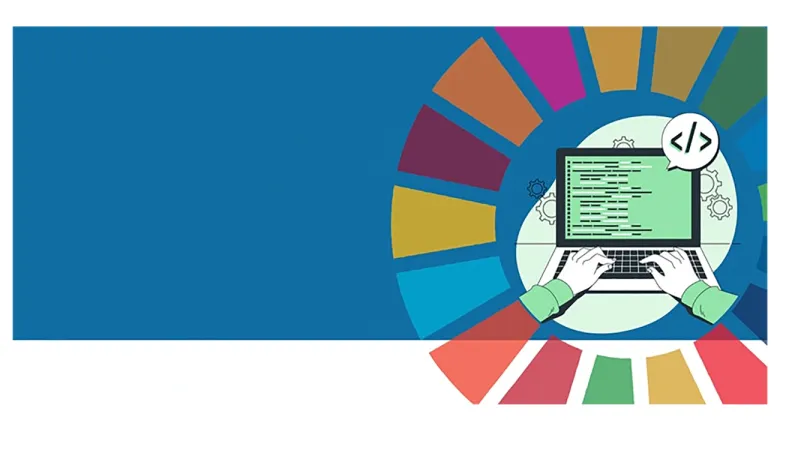Share the page
Using Artificial Intelligence to Assess Progress towards the UN Sustainable Development Goals
Published on

ChatGPT seems to be taking the world by storm. Typing a few words of instruction can prompt the chatbot to pen essays, ad campaigns or even film scripts. (A Hollywood blockbuster written by a robot is no longer the stuff of science-fiction.) But AI is already being used for important development initiatives.
AFD Group has created its own AI system that could revolutionize the way we assess the activities of Public Development Banks. The Group is now using innovative AI tools to measure the degree to which institutions support the UN Sustainable Development Goals, for instance. AFD economist Jean-Baptiste Jacouton and data officer Adeline Laulanié, explain how.
Originally published in May, 2022, this article was updated on 19 January, 2023.
The Sustainable Development Goals (SDGs) serve as a roadmap for a growing number of public development banks. How do these banks report on their progress (or otherwise) in contributing to the fulfillment of the 17 SDGs?
Jean-Baptiste Jacouton: The majority of Public Development Banks (PDBs) publish an annual activity report, and sometimes a sustainable development report. Unfortunately, not all of these banks report on their alignment with the 2030 Agenda in the same way, and the activity report content varies from one institution to another. In most cases, banks simply highlight a few of their flagship projects, without specifying the value of their SDG commitments. Some PDBs provide a simplified breakdown of their financing according to the 17 SDGs.
For example, for a single €10 million project contributing to both gender issues and climate change, the bank may report €10 million in financing for SDG 5, “Gender Equality”, as well as €10 million for SDG 13, “Climate Action”. Other institutions use more precise breakdown methods.
The lack of a common methodology prevents the aggregation of data on public development banks’ commitments, and, therefore it's difficult to assess progress made in closing the SDG finance gap. According to the OECD, this gap amounts to US$4.2 trillion per year.
However, PDBs – which account for around 10% of annual global investment – are required to play a major role in achieving the Sustainable Development Goals, in particular by attracting private financing for projects that support the Paris Agreement, by promoting biodiversity protection and reducing inequalities. This message has been conveyed by groups such as the International Development Finance Club (IDFC), chaired by AFD Group, and the Finance in Common coalition, which is comprised of more than 500 institutions worldwide.
Find out more: The Proof is in the pudding: revealing SDGs using Artificial Intelligence
How can artificial intelligence improve SDG monitoring? How is this model revolutionary?
Adeline Laulanié: The SDGs are often still monitored manually using declarative data. Of course, this approach has its limitations: the monitoring process is not systematic, it can be subjective, and the methodology used may differ between one institution and another.
AI can automatically analyze any document and create an SDG map with a unique methodology in mere seconds. A number of institutions like the OECD (SDG Tracker) or the UN (LinkedSDG) have developed their own algorithms, based on counting the frequency of words. However, these traditional methods are still in the testing phase and have significant technical limitations. These technologies cannot be used to read multi-page documents, for example. With this in mind, AFD group decided to develop its own AI model using more powerful algorithms: the SDG Prospector.
The SDG Prospector uses deep learning based on a language analysis model (or Natural Language Processing) recently developed by Facebook. With this method, the AI model not only counts the frequency of SDG-related words, but learns to speak “SDG language” and contextualizes sentences, thus performing a highly powerful SDG document analysis.
At present, the SDG Prospector is unique: it is the only form of AI capable of reading a document of several hundred pages in a few seconds, and of transposing this data into a relevant SDG map. As a result of our research project on public development banks, led by Régis Marodon, economist and special advisor on sustainable finance at AFD, the SDG Prospector was used to analyze nearly 1,500 annual activity reports – in just a few hours!
The Sustainable Development Analysis developed by AFD, for example, seeks to expand the Prospector’s reading material beyond annual activity reports, and possibly apply it to other fields outside of the 17 SDGs.
To take this to the next level, AFD launched a “hackathon” along with the School of Digital Engineers (ISEP) and the United Nations Environment Programme, held in mid-May 2022. What are the objectives of this unprecedented challenge?
J.-B. J. & A. L.: A growing number of institutions and development stakeholders are interested in applying AI solutions to support the SDGs. The United Nations Environment Programme and ISEP School of Engineers in Paris have thus developed their own SDG mapping tool, via the SDG Meter. We devised this challenge together to rally support around the Sustainable Development Goals and raise awareness among data scientists, whether students or professionals, of the key role they can play in achieving these common goals. In short, this is a great example of how to mobilize collective intelligence and offers a wonderful opportunity to share knowledge.
The Hackathon took place from May 13 to 15, at ISEP School of Engineers, 10 Rue de Vanves, 92130 Issy-les-Moulineaux, southwest of Paris.
